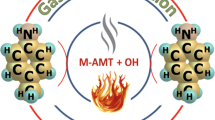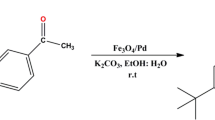Abstract
The mechanisms of the acid-catalyzed decarboxylation of pyrrole-2-carboxylic acid and mesitoic acid have been investigated based on density functional theory calculations at the B3LYP/6-311G (d, p) level. A polarizable continuum model (PCM) has been established in order to evaluate the effects of solvents on these reactions. The results of the calculations indicate that the first step of the acid-catalyzed decarboxylation of the pyrrole-2-carboxylic acid has two possible pathways, that is, the proton of H3O+ attacks either the α-carbon atom or the carboxyl oxygen atom. The subsequent process of forming a four-membered ring transition state is the rate-determining step. The activation energies of acid-catalyzed decarboxylation of pyrrole-2-carboxylic acid proceeding via attack at the α-carbon atom and the carboxyl oxygen atom are determined to be 194.21 and 210.41 kJ/mol, respectively. The computational results show that both pathways are favored. However, for the reaction of mesitoic acid with H3O+, the reaction barrier for the former pathway is calculated to be 212.15 kJ/mol, whilst the latter pathway has a reaction barrier of 200.45 kJ/mol. Our computational results are consistent with the experimental observations of Mundle and Kluger.
Similar content being viewed by others
References
Brown BR. The mechanism of thermal decarboxylation. Quart Rev Chem Soc, 1951, 5: 131–146
Bender ML. Mechanisms of catalysis of nucleophilic reactions of carboxylic acid derivatives. Chem Rev, 1960, 60: 53–113
Green S, Schor H, Siegbahn P, Thaddeus P. Theoretical investigation of protonated carbon dioxide. Chem Phys, 1976, 17: 479–485
Seeger U, Seeger R, Pople JA, Schleyer PvR. Isomeric structures of protonated carbon dioxide. Chem Phys Lett, 1978, 55: 399–403
Redington RL. Kinetics of oxygen-18 exchange between carboxylic acids and water. J Phys Chem, 1976, 80: 229–235
Chiang Y, Whipple EB. The protonation of pyrroles. J Am Chem Soc, 1963, 85: 2763–2767
Klages A, Lickroth G. Ueber die Abspaltbarkeit von Substituenten aus dem Benzolkern. Das Verhalten des Ketonrestes und der Carboxylgruppe. Chem Ber, 1899, 32: 1549–1565
Schubert WM. The aromatic elimination reaction. I. Mechanism of the decarboxylation of mesitoic acid. J Am Chem Soc, 1949, 71: 2639–2644
Mundle SOC, Lacrampe-Couloume G, Lollar BS, Kluger R. Hydrolytic decarboxylation of carboxylic acids and the formation of protonated carbonic acid. J Am Chem Soc, 2010, 132: 2430–2436
Mundle SOC, Kluger R. Decarboxylation via addition of water to a carboxyl group: Acid catalysis of pyrrole-2-carboxylic acid. J Am Chem Soc, 2009, 131: 11674–11675
Frisch MJ, Trucks GW, Schlegel HB, Scuseria GE, Robb MA, Cheeseman JR, Zakrzewfki VG, Montgomery JA, Stratmann RE, Burant JC, Dapprich S, Millam JM, Daniels AD, Kudin KN, Strain MC, Farkas O, Tomasi J, Barone V, Cossi M, Cammi R, Mennucci B, Pomelli C, Adamo C, Clifford F, Ochterski J, Petersson GA, Ayala PY, Cui Q, Morokuma K, Malick DK, Rabuck AD, Raghavachari K, Foresman JB, Cioslowski J, Ortiz JV, Stefanov BB, Liu G, Liashenko A, Piskorz P, Komaromi I, Gomperts R, Martin RL, Fox DJ, Keith T, Al-Laham MA, Peng CY, Nanayakkara A, Gonzalez C, Challacombe M, Gill PMW, Johnson BG, Chen W, Wong MW, Andres JL, Head-Gordon M, Replogle ES, Pople JA. GAUSSIAN 03, (Revision D. 01), Gaussian, Inc., Pittsburgh PA, 2003
Becke AD. Density-functional exchange-energy approximation with correct asymptotic behavior. Phys Rev A, 1988, 38: 3098–3100
Becke AD, Kohn W, Parr RG. Density functional theory of electronic structure. J Phys Chem, 1996, 100: 12974–12980
Stephens PJ, Devlin FJ, Chabalowski CF. Ab initio calculation of vibrational absorption and circular dichroism spectra using density functional force fields. J Phys Chem, 1994, 98: 11623–11627
Rassolov VA, Ratner MA, Pople JA, Redfern PC, Curtiss LA. 6-31G* basis set for third-row atoms. J Comput Chem, 2001, 22: 976–984
Fukui K. A formulation of the reaction coordinate. J Phys Chem, 1970, 74: 4161–4163
Gonzalez C, Schlegel HB. An improved algorithm for reaction path following. J Chem Phys, 1989, 90: 2154–2161
Tomasi J, Persico M. Molecular interactions in solution: An overview of methods based on continuous distributions of the solvent. Chem Rev, 1994, 94: 2027–2094
Mineva T, Russo N, Sicilia E. Solvation effects on reaction profiles by the polarizable continuum model coupled with the Gaussian density functional method. J Comput Chem, 1998, 19: 290–299
Author information
Authors and Affiliations
Rights and permissions
About this article
Cite this article
Zhang, X., Geng, Z. & Wang, Y. Density functional theory study of the mechanism of the acid-catalyzed decarboxylation of pyrrole-2-carboxylic acid and mesitoic acid. Sci. China Chem. 54, 762–768 (2011). https://doi.org/10.1007/s11426-011-4265-3
Received:
Accepted:
Published:
Issue Date:
DOI: https://doi.org/10.1007/s11426-011-4265-3




